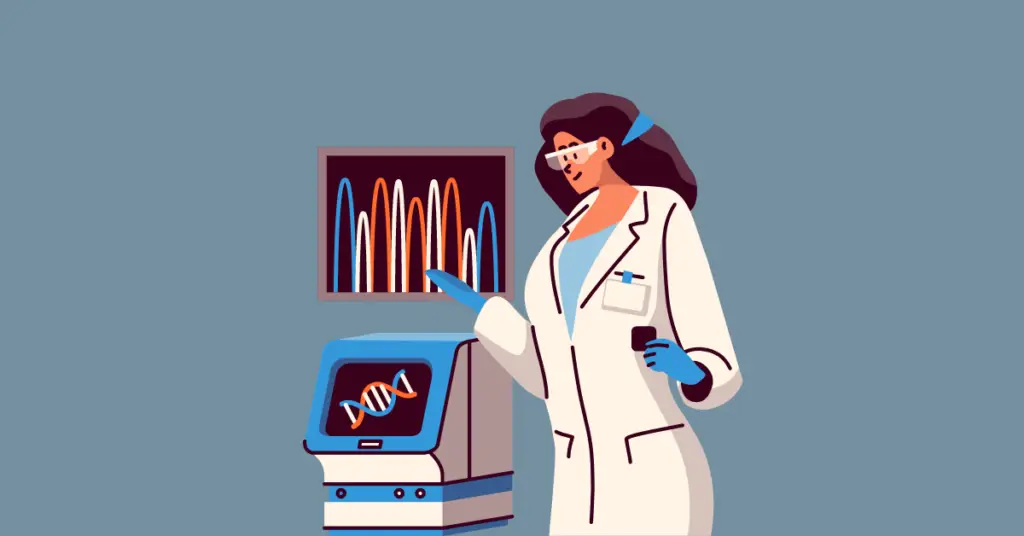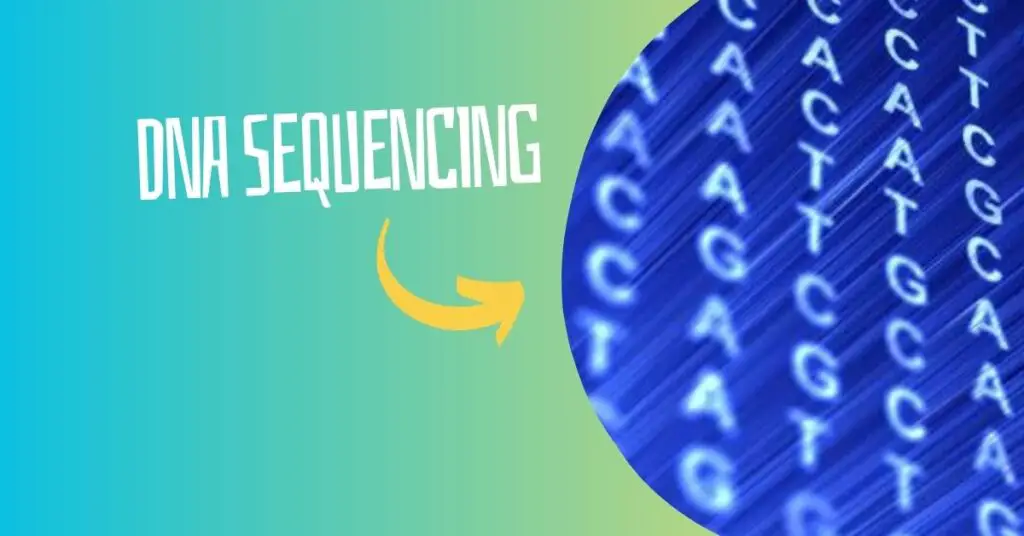“Do you want to know about various types of sequencing techniques? Here is the comprehensive list of 47 types of sequencing techniques used in genetics.”
DNA sequencing is an important molecular genetic technique. It enables scientists to read the sequence of target DNA fragments. However, various types of sequencing platforms can often lead to confusion in grasping the knowledge.
It is important to note that the present blog does not follow a specific or hierarchical classification; rather, it constitutes a random compilation of sequencing methodologies frequently inquired about by students on the internet. Thus, this article comprehensively explains each technique.
So this is an overview type of blog article that helps you understand the fundamental concept of various types of sequencing techniques we use in genetics.
Stay tuned.
Related article: DNA Sequencing: History, Steps, Methods, Applications and Limitations.
Key Topics:
47 Types of Sequencing Techniques
1. Sanger Sequencing
Conventional sequencing technique, developed by Friedreich Sanger. It’s based on the principle of chain termination in which the synthesis reaction is terminated when it encounters ddNTP instead of dNTP. Usually, employed to sequence shorted DNA fragments.
2. Maxam-Gilbert Sequencing
Often known as chemical sequencing, the present technique has been developed by Allan Maxam and Walter Gilbert. The DNA is selectively chemically modified using reagents like hydrazine, piperidine, formic acid, and dimethyl sulfate and separated on the PAGE. The present technique can effectively sequence smaller DNA fragments.
3. Next-generation sequencing
NGS is a revolutionary high-throughput and ultra-sensitive sequencing technique. It can sequence millions of short and large DNA fragments simultaneously in a single reaction. It has widespread applications in genome studies, diagnostics and genome-wide SNP analysis.
4. Pyrosequencing
Pyrosequencing works on the principle of light emission. During the synthesis reaction, the released pyrophosphate is recorded for sequencing purposes. Pyrosequencing can effectively sequence shorter DNA fragments between 300 to 500 base pairs.
5. Targeted Sequencing
It is a technique to selectively sequence a specific region or sequence or gene segment from the entire genome or whole gene. It allows focused analysis of a particular gene or genomic region.
Related article: What is Targeted Sequencing and How Does It Work?
6. RNA Sequencing
It sequences the RNA present in the sample and is thus utilized for gene expression studies. Common techniques are mRNA-Seq, total RNA-Seq, and small RNA-Seq.
Related article: RNA Sequencing- Principle, Steps, Methods And Applications.
7. Bisulfite Sequencing
The present sequence technique is used to study DNA methylation patterns. To do so, the sample is treated with bisulfite converting unmethylated cytosine to uracil. It is used for epigenetic studies.
8. Metagenomic Sequencing
It is a technique to sequence genetic material obtained from various environmental samples carrying various microbial organisms. Techniques like NGS and shotgun sequencing have been used. It enables scientists to study the microbial population of the ecosystem.
9. De novo Sequencing
It is a specialized technique opt-in when no reference sequence or genome is available for comparative analysis. Meaning, sequencing and assembling are performed from scratch. It helps study species with no closely related sequenced genomes.
10. Exome Sequencing
The present sequencing technique can only read the coding regions of the genome. Meaning, sequences that are involved in protein synthesis. It helps us to study variations associated with various genes and their role in disease development.
Related article: What is Whole-Exome Sequencing?
11. ChIP Sequencing (ChIP-Seq)
ChIP-Seq is Chromatin Immunoprecipitation sequencing that sequences regions involved in protein-DNA interactions. Meaning, it helps study the regions where various protein binds to DNA.
Related article: The Concept of ChIP-Seq (ChIP-Sequencing) Explained.
12. Mate Pair Sequencing
It sequences larger DNA fragments typically between 2 to 5 kb in size from both sides, Just like the paired-end sequencing. It is used in de novo sequencing, finding structural variations and genome assembling.
13. Paired-end Sequencing
It sequences shorted DNA fragments typically between 200 to 800 base pairs from both ends. It can accurately provide the sequence information as well as the distance between various DNA fragments.
14. Epigenomic Sequencing
Epigenomics is actually a broad term used for sequencing those DNA regions having a role in gene expression regulation and epigenetic modifications. Put simply, it can sequence regions that control gene expression.
15. Long Read Sequencing
is Often known as third-generation sequencing. LRS is a technique that can effectively sequence longer DNA regions < 20 Kb in size. It helps in de novo genome assembling and studying complex genomic regions.
16. Cycle Sequencing
It’s a variant of the conventional Sanger Sequencing technique in which the sensitivity, accuracy and efficiency of sequencing reaction can be enhanced by using the PCR. The template region is first enriched using PCR amplification, before sequencing.
17. RAD-Seq (Restriction site-Associated DNA Sequencing)
RAD-Seq is Restriction site-associated DNA sequencing. It sequences specific regions associated with restriction digestion or specific restriction enzymes. RAD is a genetic marker used for QTL mapping and population studies.
18. Amplicon Sequencing
It is a technique targeting a specific and PCR-amplified region or sequence. It’s also known as targeted sequencing. The approach is widely used in 16s rRNA gene sequencing.
19. Shotgun Sequencing
It allows the sequencing of random-sized DNA fragments and assembling them based on overlapping region analysis. Shotgun sequencing has been utilized for metagenomic sequencing where the input DNA fragment sizes are random.
Related article: A Guide To Next-Generation Shotgun Sequencing In Metagenomics: Technique, Advantages and Challenges.
20. TILLING Sequencing
TILLING is Targeting Induced Local Lesions IN Genomics. It’s a reverse genetic technique that identifies chemically induced sequence variants. The present method is widely used in plant genetic research.
21. 3D Sequencing
3D sequencing is Chromosome Conformation Capture Sequencing. It allows studying spatial chromosomal organization and chromatin folding and remodeling.
22. 4D Sequencing
4D sequencing is Circular Chromosome Conformation Capture Sequencing which is the advanced version of the 3D sequencing technique and is used to study chromatin looping events.
23. Capture Sequencing
Capture sequencing is an NGS-based technique used for studying thousands of different target regions from the genome including complex genomic regions. The regions are enriched prior to sequencing. We can, it’s a higher version of amplicon or targeted sequencing.
24. CRISPR Sequencing
As the name suggests the present sequencing technique is utilized to study a specific and CRISPR-CAS9 edited region from the genome. It is used to validate the success and specificity of the CRISPR gene editing technique.
25. Whole-genome sequencing
WGS is an NGS-based sequencing approach that has the power to sequence the entire genome of an organism. It can identify SNPs and genomic variants from the genome. Meaning, it reveals the genetic makeup of an organism.
Related article: What is Genome Sequencing?- 3 Best Genome Sequencing Methods
26. microRNA Sequencing
microRNA sequencing belongs to epigenetic sequencing. mRNAs are smaller non-coding RNAs involved in gene expression regulation. The present sequencing technique specifically studies those microRNAs.
27. Expression Sequencing
Again, it’s a type of epigenetic sequencing that particularly sequences the Expression Sequence Tags (ESTs) thereby identifying gene transcripts.
28. MeDIP-Seq
MeDIP-Seq is Methylated DNA Immunoprecipitation sequencing. In this technique, the methylated cytosine-rich genomic regions are sequenced. It helps studying DNA methylation thereby helping in epigenetic studies.
29. RRB-Sequencing
RRBS is Reduced Representation Bisulfite Sequencing. It is a combination of bisulfite sequencing and RAD sequencing that allows studying epigenetically important DNA sequences.
30. dP-Seq
dP-Seq is a Digital PCR sequencing technique. It’s a combination of digital PCR and sequencing. It’s a third-generation sequencing method that can accurately quantities sequence libraries as well.
31. Sequencing for Functional Genomics
The present method is used to sequence the functionally important sequences of the genome and helps understand the function of various genomic loci.
32. ATAC-Seq
ATAC-Seq is Chromatin-Accessibility Sequencing. It studies chromatins, chromatin accessibility and chromatin packaging across the entire genome. This helps study and understand epigenetics. We can say, it’s a type of epigenetic sequencing.
33. Pooled Library Sequencing
Put simply, multiple samples, for example, multiple plasmids can be sequenced in a single reaction using a pooled library sequencing approach. For large-scale genomic projects, it saves costs, without compromising the sequencing efficiency.
34. Shallow Sequencing
It’s a high-throughput DNA sequencing technique that enables identifying genomic variations from many different species. It’s often known as low-pass genome sequencing due to its lower coverage depth.
35. CAGE-Seq
CAGE-Seq is a Cap-Analysis of Gene Expression Sequencing. It is also employed for gene expression studies that can typically sequence and read transcription start sites on mRNA.
36. Single-Cell Sequencing
Also known as Single Cell DNA Sequencing (scDNA-Seq), the present technique allows the sequencing of a single cell’s genome. It’s a next-generation sequencing-based approach.
37. CLIP-Seq
CLIP-Seq is cross-linking and Immunoprecipitation sequencing. It typically investigates protein’s RNA-binding sites and helps study post-transcriptional gene regulation.
38. High-Throughput Sequencing
High-throughput sequencing is not a specific technique. It’s a general term used for the type of sequencing, for example, NGS that can simultaneously study a large number of DNA sequences from the sample.
39. SOLiD Sequencing
SOLiD Sequencing is Sequencing by Oligonucleotide Ligation and Detection. It uses a specialized ligation-based chemistry for accurate DNA sequencing.
40. SMRT Sequencing
SMRT is Single Molecular Real-Time Sequencing. It monitors the addition of nucleotides in real time during the reaction. The technology is developed by Pacific Biosciences.
41. MPSS
MPSS stands for Massive Parallel Signature Sequencing. It can sequence, read and quantity mRNA transcript and thus, beneficial in gene expression and epigenetic studies.
42. Polony Sequencing
The present technique is a cheaper and high-throughput sequencing technique that can read many DNA sequences in a single run. However, it uses a solid support to amplify the DNA.
43. Solexa Sequencing
Solexa sequencing is an Illumina sequencing technique that works on the principle of sequencing by synthesis using the reversible dye termination method. It is an efficient and accurate parallel sequencing method.
44. Ion Torrent Semi-Conductor Sequencing
Also known as the Ion Torrent sequence, the present technique sequences the DNA by detecting the hydrogen ions released during the nucleotide incorporation. Ion Torrent sequencing is the most versatile and popular sequencing platform.
45. DNA Nanoball Sequencing
It’s a high-throughput DNA sequencing technique that reads the target DNA sequences using DNA nano-balls. Such small and dense nanoballs are generated by rolling circle replication.
46. Sequencing by Hybridization
It is a technique based on probe-hybridization as sequencing chemistry and overlapping sequence assembly to assemble fragments. Sequencing by hybridization is a conventional sequencing approach.
47. Nanopore Sequencing
The present sequencing technique is a third-generation sequencing platform that uses nanopores to sequence the DNA. It’s a selective sequencing technique that only reads the sequence passing through the nanopore. It is used in genomic, transcriptomics and epigenomic studies.
Wrapping up
This article serves as a preliminary overview of various sequencing techniques that have come to your attention, either through personal knowledge or online sources. I will prepare detailed articles for each technique in the future.
It is anticipated that this article has provided a foundational understanding of the key principles underlying sequencing techniques. I hope you like this article, please share it and do bookmark the page.


